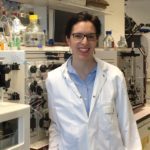Lien vers Pubmed [PMID] – 25187552
Lien DOI – 10.1128/JVI.01204-14
J Virol 2014 Nov; 88(22): 13064-72
Membrane fusion in herpesviruses requires viral glycoproteins (g) gB and gH/gL. While gB is considered the actual fusion protein but is nonfusogenic per se, the function of gH/gL remains enigmatic. Crystal structures for different gH homologs are strikingly similar despite only moderate amino acid sequence conservation. A highly conserved sequence motif comprises the residues serine-proline-cysteine corresponding to positions 437 to 439 in pseudorabies virus (PrV) gH. The PrV-gH structure shows that proline(438) induces bending at the end of an alpha-helix, thereby placing cysteine(404) and cysteine(439) in juxtaposition to allow formation of a strictly conserved disulfide bond. However, PrV vaccine strain Bartha unexpectedly carries a serine at this conserved position. To test the influence of this substitution, we constructed different gH chimeras carrying proline or serine at position 438 in gH derived from either PrV strain Kaplan or strain Bartha. Mutants expressing gH with serine(438) showed reduced fusion activity in transient-fusion assays and during infection, with delayed penetration kinetics and a small-plaque phenotype which indicates that proline(438) is important for efficient fusion. A more drastic effect was observed when disulfide bond formation was completely blocked by mutation of cysteine(404) to serine. Although PrV expressing gHC(404)S was viable, plaque size and penetration kinetics were drastically reduced. Alteration of serine(438) to proline in gH of strain Bartha enhanced cell-to-cell spread and penetration kinetics, but restoration of full activity required additional alteration of aspartic acid to valine at position 59.The role of the gH/gL complex in herpesvirus membrane fusion is still unclear. Structural studies predicted a critical role for proline(438) in PrV gH to allow the formation of a conserved disulfide bond and correct protein folding. Functional analyses within this study corroborated these structural predictions: mutation of this residue resulted in a drastic impairment of membrane fusion kinetics not only in vitro in transient transfection-fusion assays but also during virus infection. Elimination of formation of the disulfide bond yielded the same phenotype in transient assays but had a more drastic effect on virus replication. Thus, our studies add important information to structure-function analyses of herpesvirus gH.


